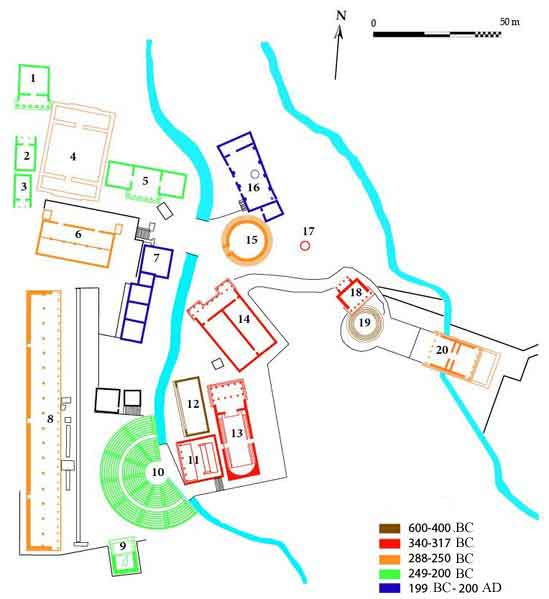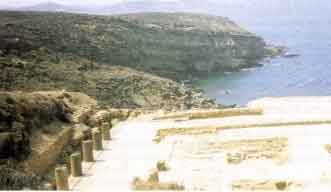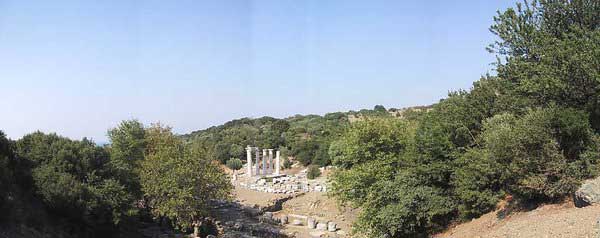.
Cabeiri in Greek mythology, were a group of minor deities, of whose character and worship nothing certain is known. Their chief seats of worship were the islands of Lemnos, Imbros and Samothrace, the coast of Troas, Thessalia and Boeotia.
The name appears to be of Phoenician origin, signifying the "great" gods, and the Cabeiri seem to have been deities of the sea who protected sailors and navigation, as such often identified with the Dioscuri, the symbol of their presence being St Elmo's fire.
Originally the Cabeiri were two in number, an older identified with Hephaestus (or Dionysus), and a younger identified with Hermes, who in the Samothracian mysteries was called Cadmilus or Casmilus. Their cult at an early date was united with that of Demeter and Kore, with the result that two pairs of Cabeiri appeared, Hephaestus and Demeter, and Cadmilus and Kore.
According to Mnaseas (quoted by the scholiast on Apollonius Rhodius i. 917) they were four in number: Axieros, Axiokersa, Axiokersos, and Casmilus. It is there stated that Axieros is Demeter; Axiokersa, Persephone; Axiokersos, Hades; and Casmilus, Hermes. The substitution of Hades for Hephaestus is due to the fact that Hades was regarded as the husband of Persephone.
Cabeiro, who is mentioned in the logographers Acusilaus and Pherecydes as the wife of Hephaestus, is identical with Demeter. Roman antiquarians identified the Cabeiri with the three Capitoline deities or with the Penates.
In Lemnos an annual festival of the Cabeiri was held, lasting nine days, during which all the fires were extinguished and fire brought from Delos. From this fact and from the statement of Strabo x. p. 473, that the father of the Cabeiri was Camillus, a son of Hephaestus, the Cabeiri have been thought to be, like the Corybantes, Curetes and Dactyli, demons of volcanic fire. But this view is not now generally held. In Lemnos they fostered the vine and fruits of the field, and from their connection with Hermes in Samothrace it would also seem that they promoted the fruitfulness of cattle.
Aeschylus wrote a play called the Kabeiroi and the fragments that survive have them as a chorus greeting the Argonauts at Lemnos. There seems to be a raucous burlesque character to the mysteries of the Kabeiroi: wine-vessels are the only characteristic finds, and an inscription at Lemnos indicates parapaizonti, the one who "jests along the way" (Burkert 1985).

Samothrace sancturary plan (Source)
By far the most important seat of their worship was Samothrace. Here, as early as the 5th century BC, their mysteries, possibly under Athenian influence, attracted great attention, and initiation was looked upon as a general safeguard against all misfortune. But it was in the period after the death of Alexander the Great that their cult reached its height. Demetrius Poliorcetes, Lysimachus and Arsinoë regarded the Cabeiri with especial favour, and initiation was sought, not only by large numbers of pilgrims, but by persons of distinction. Initiation included also an asylum or refuge within the strong walls of Samothrace, for which purpose it was used among others by Arsinoë, who, to show her gratitude, afterwards caused a monument to be erected there, the ruins of which were explored in 1874 by an Austrian archaeological expedition.

Kabeiroi Sanctuary, Lemnos
In 1888 interesting details as to the Boeotian cult of the Cabeiri were obtained by the excavations of their temple in the neighbourhood of Thebes, conducted by the German archaeological institute. The two male deities worshipped were Cabeiros and a boy: the Cabeiros resembles Dionysus, being represented on vases as lying on a couch, his head surrounded with a garland of ivy, a drinking cup in his right hand; and accompanied by maenads and satyrs. The boy is probably his cup-bearer. The Cabeiri were held in even greater esteem by the Romans, who regarded themselves as descendants of the Trojans, whose ancestor Dardanus (himself identified in heroic legend with one of the Cabeiri) came from Samothrace. The identification of the three Capitoline deities with the Penates, and of these with the Cabeiri, tended to increase this feeling.
In Thebes there are more varied finds, which include many little bronze votive bulls and which carry on into Roman times, when the traveller Pausanias, always alert to the history of cult, learned that it was Demeter Kabeiriia who instigated the initiation cult there in the name of Prometheus and his son Aitnaios. Walter Burkert (1985) says, "This points to guilds of smiths analogous to the Lemnian Hephaistos." The votive dedications at Thebes are to a Kabiros in the singular, and childish toys like votive spinning tops for Pais suggest a manhood initiation. Copious wine was drunk, out of characteristic cups that were ritually smashed. Fat, primitive dwarves like the followers of Silenus, with prominent genitalia were painted on the cups.
Diodorus Siculus said of the Kabeiroi that they were Idaioi dactyloi— "Idaian dactyls" in the sense of Phrygian Mount Ida, sacred to the goddess— there was also a suggestion that the mysteries associated with Orpheus had their origins among the Kabeiroi. Outsiders might easily confuse the Kabeiroi with the Korybantes, the Kuretes, the Telchines of Rhodes, and among the Minyans of Lemnos, the Hephaistoi— the "Hephaestus-men" who knew the mysteries of the forge and the secret arts of metal-working— all venerated by initiated men's groups, whose origins lay in the most distant past.

Hieron in Samothrace, mysteries of the Kabeiroi sancturary
In Classical Greek culture the mysteries of the Kabeiroi at Samothrace remained popular, though little was entrusted to writing beyond a few names and bare genealogical connections. Seamen among the Greeks might invoke the Kabeiroi as "great gods" in times of danger and stress. The archaic sanctuary of Samothrace was rebuilt in Greek fashion; by classical times the Samothrace mysteries of the Kabeiroi were known at Athens. Herodotus had been initiated. But at the entry to the sanctuary, which has been thoroughly excavated, the Roman antiquary Varro learned, there had been twin pillars of brass, phallic like herms, and in the sanctuary it was understood that the child of the Goddess, Kadmilos, was in some mystic sense also her consort.
NAMA 424 : Kabeiric skyphos.
NAMA 10424 : Kabeiric Skyphos
References
Gods of the Greeks, Carl Kerenyi
Greek Religion, Walter Burkert
See also : Greek Mythology. Paintings, Drawings
| Ancient Greece
Science, Technology , Medicine , Warfare, , Biographies , Life , Cities/Places/Maps , Arts , Literature , Philosophy ,Olympics, Mythology , History , Images Medieval Greece / Byzantine Empire Science, Technology, Arts, , Warfare , Literature, Biographies, Icons, History Modern Greece Cities, Islands, Regions, Fauna/Flora ,Biographies , History , Warfare, Science/Technology, Literature, Music , Arts , Film/Actors , Sport , Fashion --- |
Retrieved from "http://en.wikipedia.org"
All text is available under the terms of the GNU Free Documentation License

